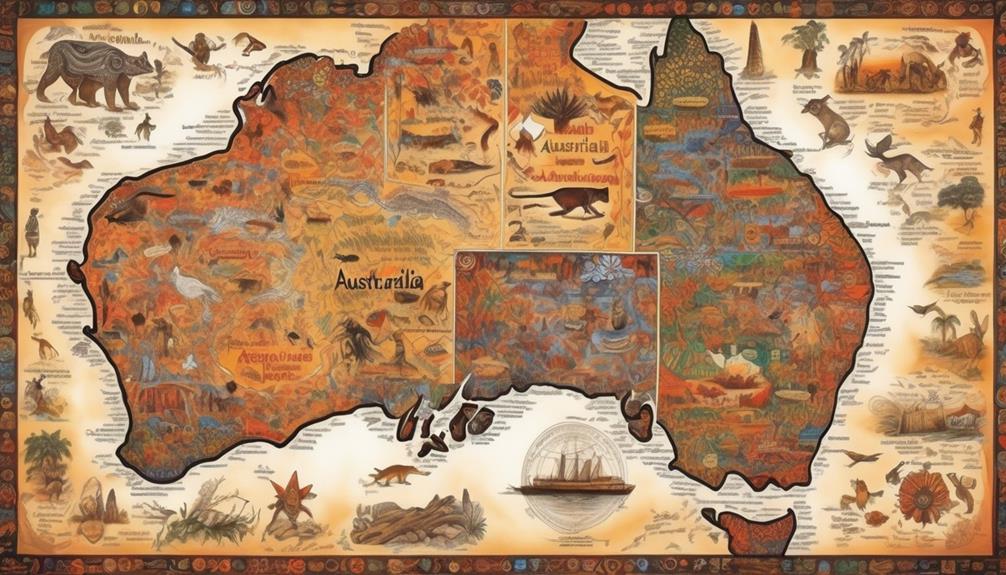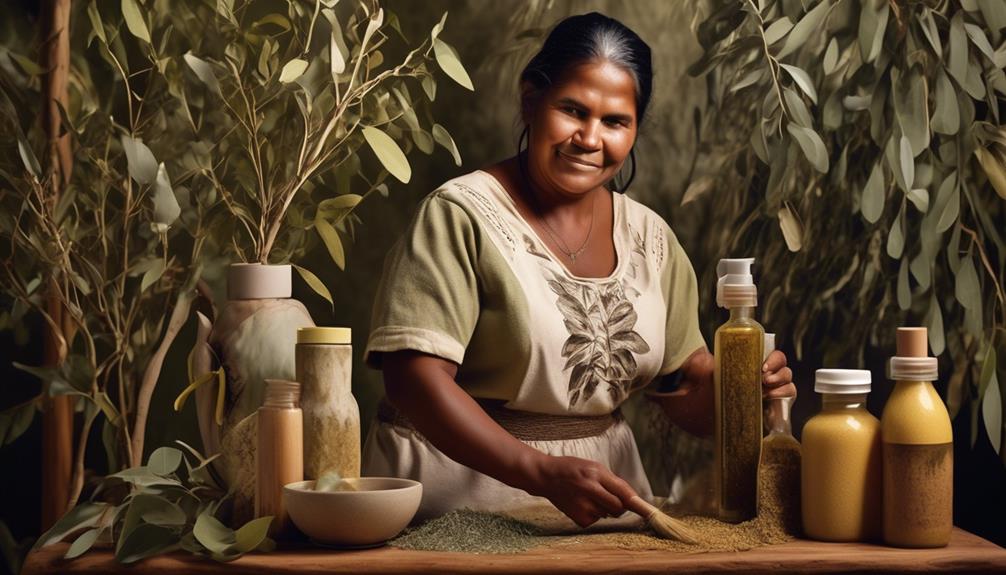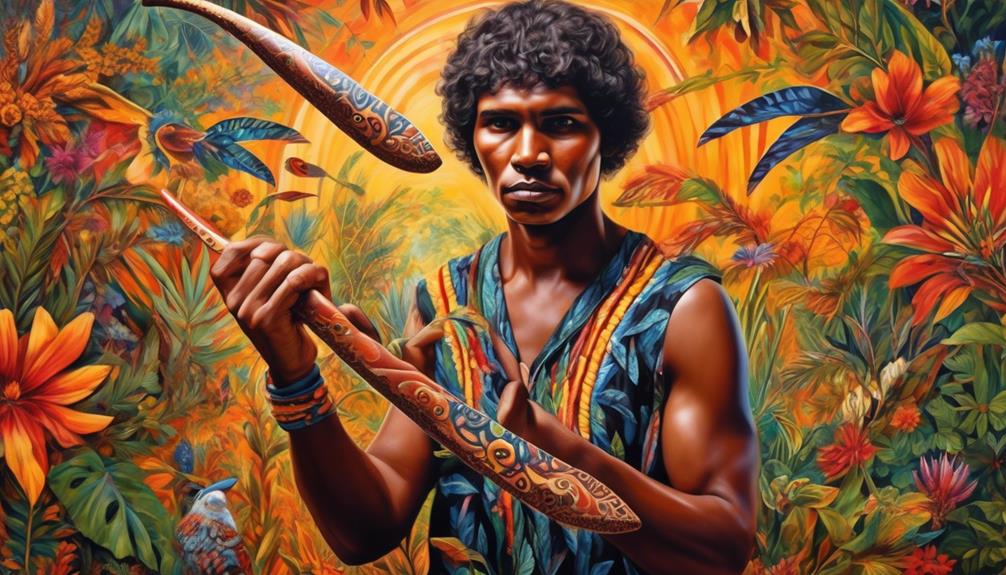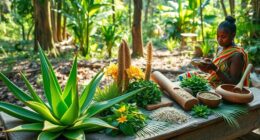The Ice Age is often overlooked, but it is fascinating to note that Aboriginal Australians not only managed to survive, but also thrived during this challenging period.
How did they manage to stay warm and adapt to the freezing temperatures? The methods and strategies they employed are not only ingenious but also provide valuable insights into their resourcefulness and resilience.
Key Takeaways
- Aboriginal Australians utilized kangaroo and possum fur, as well as expertly woven and sewn natural materials, for warmth and durability during the Ice Age.
- They manipulated plant fibers like grasses and bark for insulation, showcasing their deep understanding of the environment and resourcefulness in utilizing natural resources.
- Crafted shelters using bark and leaves for insulation, and communal knowledge and resources were important for shelter construction, emphasizing the significance of community and sharing for survival.
- Aboriginal Australians gathered and utilized animal skins for protection and insulation, employing sustainable hunting techniques based on animal behavior and migration, and utilizing natural resources for fur preservation.
Clothing and Insulation
To protect ourselves from the harsh cold of the Ice Age, Aboriginal Australians ingeniously crafted clothing and insulation using natural materials found in their environment.
The clothing design was a testament to their resourcefulness and deep understanding of the land. They utilized materials such as kangaroo and possum fur, which provided exceptional warmth and durability. These natural materials were expertly woven and sewn together to create garments that offered protection from the biting cold.
Additionally, they used plant fibers, such as grasses and bark, which were skillfully manipulated to form insulating layers for their clothing. By combining these natural resources with their advanced knowledge of the environment, Aboriginal Australians were able to create highly effective clothing and insulation that enabled them to thrive in the challenging conditions of the Ice Age.
This resourcefulness and ingenuity exemplify the deep connection and respect they had for the land, utilizing its offerings to serve their fundamental needs.
The clothing and insulation methods developed by Aboriginal Australians during the Ice Age continue to inspire admiration for their profound understanding of nature and how best to utilize its gifts.
Shelter and Fire

Crafting sturdy shelters and building fires were essential skills for Aboriginal Australians during the Ice Age, enabling us to protect ourselves from the elements and thrive in our harsh environment.
Our shelters were crafted using natural materials like bark and leaves, providing excellent insulation against the cold. We relied on the knowledge passed down through generations to construct these shelters, utilizing the resources available to us in the environment.
The importance of community and sharing was integral to our survival. We worked together to gather materials, build shelters, and maintain fires, ensuring the well-being of every member of our community. The act of sharing knowledge, skills, and resources was a fundamental aspect of our culture, and it played a crucial role in our ability to withstand the challenges of the Ice Age.
Use of Animal Skins

Gathering and utilizing animal skins was a vital practice for Aboriginal Australians during the Ice Age, providing us with essential protection and insulation against the harsh elements of our environment. Our hunting techniques were honed to ensure the respectful and sustainable acquisition of animal skins. This involved intricate knowledge of animal behavior, migration patterns, and the optimal timing for hunting.
In addition, our ancestors developed sophisticated fur preservation methods to ensure the durability and warmth of the animal skins. The process involved meticulous skinning, scraping, and tanning techniques that were passed down through generations. The use of natural resources such as plant extracts and animal fats played a crucial role in preserving the quality of the fur, allowing it to withstand the extreme conditions of the Ice Age.
The careful selection and crafting of animal skins reflected our deep respect for the natural world and our commitment to utilizing resources in a sustainable manner. This practice not only provided us with vital protection against the cold but also fostered a profound connection to the land and the creatures that sustained us.
Cultural Practices and Rituals
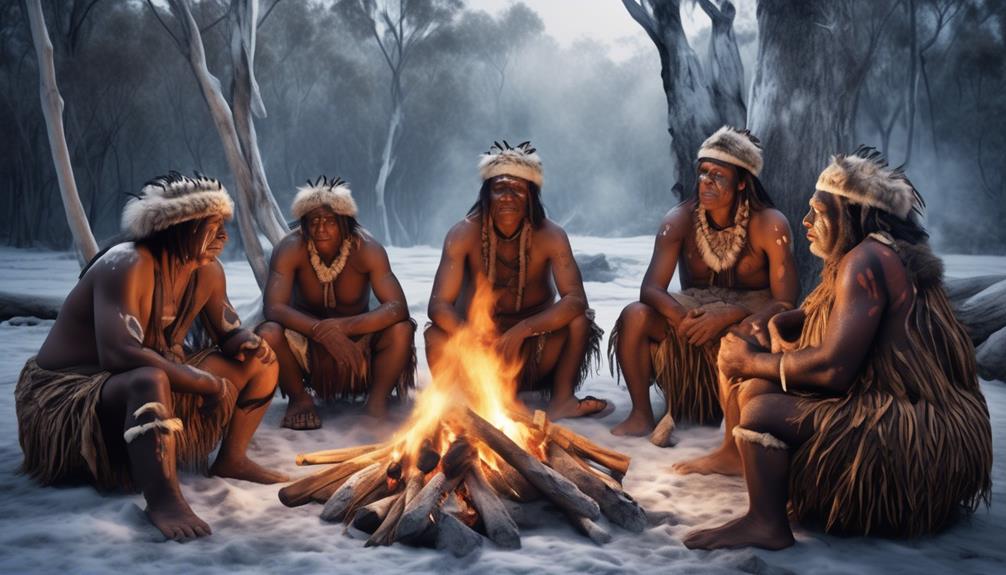
Deeply rooted in our ancestral traditions, our cultural practices and rituals have been integral to our identity and survival throughout the Ice Age. Traditional ceremonies weren't just a form of entertainment or celebration for Aboriginal Australians; they were essential for passing down survival techniques and preserving indigenous knowledge. Our ancestors used these ceremonies as a way to communicate vital skills, such as fire-making, tool crafting, and hunting strategies, ensuring that each generation was equipped to thrive in the harsh conditions of the Ice Age. These rituals also served as a means of reinforcing community bonds and sharing the wisdom of our ancestral traditions.
Indigenous knowledge was carefully woven into the fabric of our cultural practices and rituals. Through storytelling, song, and dance, our ancestors imparted invaluable survival wisdom, teaching us how to navigate the land, predict weather patterns, and identify medicinal plants. These practices weren't only a testament to our resilience but also a testament to the depth of our ancestral traditions, which continue to guide and enrich our lives today.
Adapting to Environmental Changes
Adapting to the shifting environmental conditions during the Ice Age demanded resourcefulness and resilience from Aboriginal Australians, shaping our cultural practices and survival strategies. Our ability to adapt to the changing climate was crucial for our survival. Our people developed sophisticated techniques to thrive in the harsh conditions, including:
- Shelter Building
- *Innovative Construction*: We constructed sturdy shelters using local materials such as bark, leaves, and branches, providing protection from the cold and wind.
- *Mobility*: Our nomadic lifestyle allowed us to move to more favorable areas as the climate changed, ensuring access to essential resources.
- Fire Management
- *Fire Starting*: We mastered the art of starting fires, providing warmth and protection from predators.
- *Controlled Burns*: By using controlled burns, we maintained the balance of the ecosystem, promoting new growth and attracting game for hunting.
Our adaptability to climate variations and development of survival techniques not only ensured our physical survival but also strengthened our connection to the land and enriched our cultural heritage.
Frequently Asked Questions
What Specific Techniques Did Aboriginal Australians Use to Insulate Their Shelters During the Ice Age?
Insulating techniques were crucial for survival in the Ice Age. Aboriginal Australians utilized various methods to insulate their shelters. Techniques included using natural materials like bark, leaves, and animal skins to create efficient insulation.
These methods not only helped maintain warmth but also protected against harsh weather conditions. The resourcefulness and ingenuity of these survival strategies demonstrate the deep cultural knowledge and respect for the environment that sustained Aboriginal Australians during this challenging period.
How Did Aboriginal Australians Adapt Their Cultural Practices and Rituals to Cope With the Extreme Cold During the Ice Age?
Cultural adaptation and survival strategies were crucial for Aboriginal Australians during the Ice Age.
We focused on adapting our cultural practices and rituals to cope with the extreme cold. Our ancestors used their deep understanding of the environment to create effective ways to stay warm, such as using animal skins and furs for clothing, and building insulated shelters.
These adaptations were essential for our survival and ensured that we could thrive in such challenging conditions.
Did Aboriginal Australians Have Any Unique Methods for Staying Warm That Were Not Related to Clothing, Shelter, or Fire?
We believe that community cooperation and resource utilization were integral to how Aboriginal Australians stayed warm during the Ice Age.
Through communal knowledge sharing and collaboration, they likely identified natural resources and developed innovative methods to generate heat and insulation.
This demonstrates their deep connection to the land and their ability to adapt to challenging environments.
Such practices highlight the importance of cultural resilience and resourcefulness within the Aboriginal Australian community.
How Did Aboriginal Australians Utilize Natural Resources to Create Effective Insulation for Their Clothing and Shelters During the Ice Age?
We utilized natural resources, such as animal hides and plant fibers, to create effective insulation for our clothing and shelters during the Ice Age. By harnessing the properties of these materials, we were able to stay warm in harsh conditions.
Our innovative insulation techniques allowed us to adapt to the challenging environment and thrive. This approach showcased our deep connection to the land and our resourcefulness in utilizing what nature provided.
What Role Did Community Cooperation and Sharing Play in Helping Aboriginal Australians Stay Warm During the Ice Age?
Community cooperation and resource sharing were vital for our survival during the ice age. Our traditional knowledge and survival strategies were passed down through generations, and we relied on each other to stay warm.
Working together allowed us to gather and utilize resources effectively, ensuring everyone had the necessary tools and clothing. This collaborative effort strengthened our communities and helped us endure the harsh conditions of the ice age.
Conclusion
In conclusion, our ancestors survived the ice age through resourcefulness and ingenuity. They used animal skins for clothing and insulation, built shelters and created fire for warmth. Their cultural practices and rituals also played a significant role in adapting to environmental changes.
As we reflect on their resilience, we're reminded of the strength and wisdom of our Aboriginal Australian heritage, and the enduring connection to our land and environment.
Mary is a passionate writer who brings creativity and a fresh perspective to our team. Her words have the power to captivate and inspire, making her an essential contributor to our content. Mary’s commitment to storytelling and dedication to promoting Indigenous culture ensures that her work touches the hearts of our readers. We’re fortunate to have her as part of our team.



